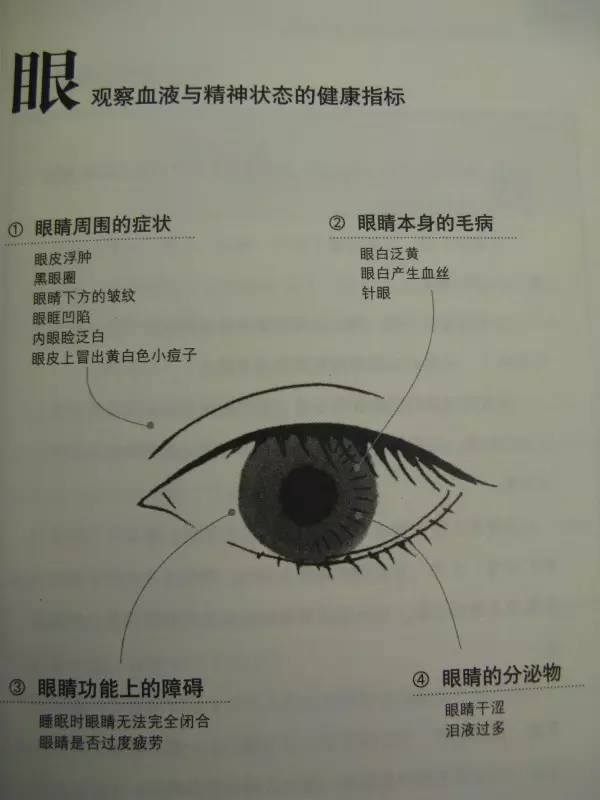Summary of TCM Courses
01
All Courses by Ni Haixia
02
Comprehensive Guide to TCM Treatments for Common Diseases
03
Focused Study on TCM Topics
04
Online Reading of TCM Learning Books
1Eyes
1. Symptoms Around the Eyes
Swollen eyelids — Indicates reduced function of internal organs (kidneys, gastrointestinal, heart) leading to water retention in the body.
Dark circles — Occur when blood contains excessive waste, causing the area around the eyes to appear dull (kidneys).
Wrinkles below the eyes — A sign of aging.
Sunken eye sockets — Indicates excessive consumption of body energy.
White inner eyelids — A symptom of anemia.
Yellowish-white bumps on eyelids — Indicates high cholesterol.
2. Eye Conditions
Yellowing of the sclera — A warning sign of liver and gallbladder issues (jaundice).
Blood vessels in the sclera — Indicates liver stress causing vascular congestion.
Eye twitching — A warning sign of weakened immunity.
3. Functional Disorders of the Eyes
Inability to fully close eyes during sleep — Indicates poor gastrointestinal function leading to overall muscle weakness.
Easy eye fatigue — Indicates liver function deficiency.
4. Eye Discharges
“Eye crust” — Yellow eye discharge indicates “pus” (inflammation).
Dry eyes — Can easily lead to eye diseases.
Excessive tearing — Occurs when liver function is weakened.

2Mouth
1. Symptoms Around the Mouth
Cracked corners of the mouth — Caused by gastritis leading to false appetite.
Acne around the corners of the mouth — Indicates weak gastrointestinal function.
Dry lips — Can occur due to elevated body temperature.
Pale lips — A warning sign of insufficient blood.
Red lips — Indicates excessive internal heat.
2. Oral Symptoms and Discharges
Stomatitis — Evidence of lowered immunity.
Bad breath — Can have five causes (active gastritis, indigestion, rhinitis, gum disease, dental plaque).
Feeling dry mouth and thick saliva — Indicates overall body fluid deficiency.
Finding a pool of saliva by the pillow in the morning — Indicates weak gastrointestinal function.
3Tongue
1. Shape of the Tongue
Jagged edges on the tongue — Indicates swelling due to excessive moisture.
Cracked tongue surface — Indicates moisture deficiency.
2. Movement of the Tongue
Slanted tongue — A signal of cerebrovascular issues.
Trembling tongue — Indicates body weakness.
3. Color of the Tongue
Red tongue body — Indicates elevated body temperature.
Pale tongue body — Indicates body weakness.
Purple tongue — A signal of thick blood.
Varicose veins on the tongue — A dangerous signal of poor blood flow.
4. Size of the Tongue
Large and thick tongue — Indicates excessive moisture in the body.
Small and thin tongue — Indicates moisture deficiency in the body.
5. Thickness of the Tongue Coating
Thick tongue coating, almost obscuring the tongue surface — Indicates gastrointestinal disorders or serious diseases.
Thin tongue coating, almost invisible — Indicates body weakness or allergic constitution.
6. Color of the Tongue Coating
White tongue coating — Indicates low body temperature and reduced body function.
Yellow tongue coating — Indicates internal “heat”.
Black tongue coating — Indicates extreme physical exhaustion.
4Nose
1. Condition of the Nose
Size of the nose — Indicates strength of respiratory function.
Nostrils flaring — Indicates difficulty in breathing.
2. Skin Condition of the Nose
Acne on the nose tip — May indicate respiratory issues.
Red nose tip — A signal of excessive alcohol consumption.
3. Nasal Discharges
Nasal discharge can indicate body temperature — Treatment for colds varies based on the type of nasal discharge.
Nasal congestion — If ignored, can lead to systemic hypoxia.
Frequent nosebleeds — Often caused by weak gastrointestinal function.
5Cheeks
1. Complexion
Red and hot cheeks — Indicates abnormal temperature regulation.
Pale cheeks — Indicates insufficient oxygen supply in the body.
2. Skin Condition
Wrinkles on the cheekbones — Mainly caused by UV exposure.
Acne on the cheeks — Pay attention to diet excess or constipation.
Enlarged pores on the cheeks — Reduced sebum is the main cause of enlarged pores.
6Teeth
1. Condition of the Teeth
Prone to cavities — A precursor to osteoporosis.
Gray teeth — Indicates the formation of cavities inside the teeth.
2. Condition of the Gums
Swollen gums — Indicates gastritis or fatigue.
Bleeding gums — Indicates gum inflammation or weak gastrointestinal function.
7Hair
1. Hair Quality
Thinning hair — Indicates a tendency towards anemia or aging.
Juvenile baldness — Excessive fat intake can lead to hair depletion (reproductive organ decline).
Excessive hair loss — Can indicate early signs of disease.
Premature graying — Related to calcium levels and hair.
Curly hair — Indicates thinning hair.
Excessive split ends and breakage — Menstruation can cause hair anemia.
2. Condition of the Scalp
Excessive dandruff — Can be classified into “dry” (iron and protein supplementation) and “oily” (improving fat metabolism, supplementing Vitamin B).
Soft and lack of elasticity scalp — Indicates symptoms of swelling.
8Nails
1. Shape of the Nails
Longitudinal cracks in the nails — Indicate “wrinkles” formed by aging.
Transverse cracks in the nails — Indicate records of “past” (body discomfort).
Prone to breakage — Indicates anemia or poor liver function.
Spoon nails — A distress signal from the body (severe anemia, uterine fibroids, endometriosis; detailed examination recommended).
Clubbing nails (feeling of pressure and deformation) — Common in individuals with heart disease.
Disappearance of the white crescent at the nail base — Indicates physical decline.
Dry nails — Indicate a state of dryness.
2. Color of the Nails
Red nails — Indicates thick blood (pay attention to cardiovascular health).
Purple-black nails — Indicates turbid blood or poor heart function.
White nails — Indicates a tendency towards anemia.
It is important to recognize that the body and mind have their own rhythms and rules, which represent the coordination and unity between humans and nature. If we do not allocate time for rest and health, we will create time for illness; if we do not allocate time for mental peace, we will create time for worry. Stop the hurried pace, calm the restless mind, and ask yourself daily: What is the most precious thing? What is the most meaningful thing? Cherish and protect the most precious things, and use limited time and energy to do the most meaningful things!

For neck, shoulder, waist, and leg pain, apply Hei Bai Tong.

